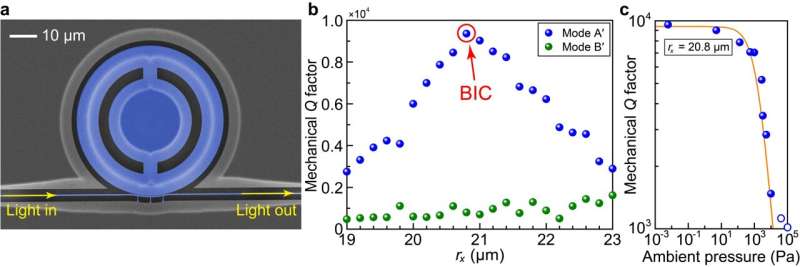

High-Q mechanical resonances are desired in many applications. The conventional wisdom relies on minimizing the size of the supporting structure of mechanical resonators, which renders the fabricated mechanical device fragile.
To overcome this difficulty, scientists in China experimentally exploited mechanical bound states in the continuum for achieving high Q factors from robust mechanical structures, which not only substantially reduces device fabrication difficulty but also enables device operation in versatile environments for broader application areas.
Integrated micro- and nanomechanical resonators, which possess a very small mass and can be strongly coupled to light and matter, have attracted intense research interests in recent years. They are not only explored for precision metrology applications like mass and force sensing but also employed for investigating macroscopic quantum physics. Reducing mechanical dissipation is crucial to many of these applications.
To this end, substantial efforts have been made in shielding the mechanical modes from the environment by using periodic structures. Besides these periodic nanomechanical devices, there exists a class of nonperiodic individual resonators (such as disk- and ring-shaped resonators) where the bandgap shielding strategy cannot be applied. Reducing mechanical dissipation in these resonators is important but remains challenging.
Bound states in the continuum (BICs) are a type of eigenstates with near zero dissipation although their eigenenergy resides in the continuous spectrum of lossy states. BICs have been exploited in optical systems to reduce their dissipation, leading to many applications such as low-threshold lasers and efficient second-harmonic generation.
Considering the success of BICs in optical systems, it is envisioned that BICs in micro- and nanomechanical systems can also be exploited for reducing their dissipation and enhancing their performance in various applications. However, the existing schemes for building BICs resort to periodic structures, which usually involve a large footprint (hence a large modal volume) and a large effective mass that are undesired in nanomechanical applications. BICs in nonperiodic individual resonators, which can have tighter modal confinement and a smaller mass, remain still experimentally elusive.

In a new paper published in Light: Science & Applications, a team of scientists led by Professor Xiankai Sun from Department of Electronic Engineering, The Chinese University of Hong Kong, Hong Kong SAR, China have proposed and experimentally observed mechanical BICs in an individual optomechanical microresonator.
They introduced coupling between two mechanical modes in the microresonator by breaking its azimuthal symmetry, which made one of the hybrid modes become a BIC under a certain condition, as confirmed by their experimental demonstration.
More importantly, they found that the low-loss mechanical BIC existed for a wide range of the supporting rods’ width from hundreds of nanometers to several micrometers. The high tolerance on the supporting structure’s geometry is a clear advantage in micro/nanoelectromechanical system (MEMS/NEMS) applications.
The scientists explained, “The conventional wisdom of improving MEMS/NEMS devices’ performance is by minimizing their supporting structure to reduce the energy dissipation, which on the other hand increases device fabrication difficulties and sets restrictions on their application areas.”
“For example, MEMS/NEMS devices based on delicate mechanical structures cannot be used repeatedly for fluid-based applications, because they cannot survive the ambient change from a liquid to a gas. Our demonstrated low-loss mechanical BICs can be obtained with a large and robust supporting structure, which substantially reduces the device fabrication difficulties and allows for their operation in versatile environments for broader application areas.”
The scientists added that “This work not only demonstrates the historic physical concept of ‘bound states in the continuum’ in a new system, but also can be harnessed for solving a challenging problem in the area of micro/nanoelectromechanical systems and for enabling new engineering applications.”
More information:
Yue Yu et al, Observation of mechanical bound states in the continuum in an optomechanical microresonator, Light: Science & Applications (2022). DOI: 10.1038/s41377-022-00971-w
Provided by
Chinese Academy of Sciences
Citation:
Observation of mechanical bound states in the continuum in an optomechanical microresonator (2022, November 21)
retrieved 21 November 2022
from https://phys.org/news/2022-11-mechanical-bound-states-continuum-optomechanical.html
This document is subject to copyright. Apart from any fair dealing for the purpose of private study or research, no
part may be reproduced without the written permission. The content is provided for information purposes only.